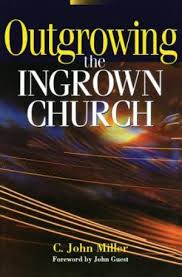BOOK REVIEW: Outgrowing the Ingrown Church by C. John Miller (1986, Zondervan) Part 1
This was a required read for my church planting residency at Redeemer Fellowship. Even though it was written in 1986, the book is just as relevant, timely, and important today. Essentially, it is a call for ingrown, self-centered, evangelism-neglecting churches and pastors to repent of sin, believe the promises of the gospel, and get on mission. I found the book soul-stirring, inspiring, and challenging. It has probably been my favorite read so far of this church planting residency and is an excellent book on a common problem facing the evangelical church.
Miller defines an ingrown church as one which lacks a “zeal for outreach” (17). Such a church cares more about its own needs, than obeying the Great Commission–making disciples of every nation (Matt 28:18-20). This ingrowness is essentially a selfishness mixed with a love of comfort and an unwillingness to take up one’s cross and share the gospel with the lost.
To help identity if a church has become ingrown, Miller gives 7 elements of introversion:
1. Tunnel vision (quiet acceptance of church dullness as normal, and numerical stagnation as inevitable, “indifference to the peril of the lost”)
2.Shared sense of group superiority (likely to exaggerate points of superiority to other churches)
3. Extreme sensitivity to negative human opinion (pride, also refusal to accept suffering and unpopularity as a cost of pacesetting church growth)
4. Niceness in tone (desire to be seen as nice, instead of holy; safe/planned rather than committed)
5. Christian Soap Opera in Style (gossip, slander)
6. Confused leadership roles (pastor is supposed to do all the work, rather than everyone is working together on mission)
7. Misdirected purpose (survival rather than conversion of the lost)
This failure needs to be addressed by the pastor, whom Miller argues needs to be a “pacesetter”—one who leads the congregation forward away from its ingrown tendencies. One of the best ways to expose cold ingrown looking is through asking intentional questions to members: “How are you growing spiritually? Do you see yourself bearing the fruit of the spirit? Have you repented of any sins lately?” (28) These questions need to be asked, because true growth in a congregation requires conflict (114). By asking these questions, church members are awakened to the fact that may have grown cold to God or are not even truly saved at all.
After identifying 7 symptoms of ingrownness, Miller reminds us the missionary character of the church and its missionary authority (ch 3-4). His main text is 1 Peter 2:9-10, which informs missionary character:
“the nature of the church is not first of all to serve itself, but God” (45); “the goal of the church is to glorify God in the world” (46). An outward looking church embraces this character by remembering that the entire church is sent on mission (53), rather than relying solely on the pastor to do all of the work, and is unafraid to use gentle confrontation with its members (50).
Later this week I share the second part of my review for this fantastic book.
